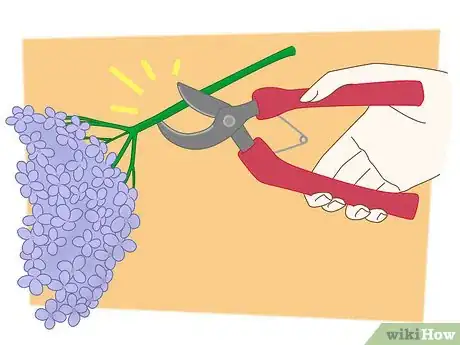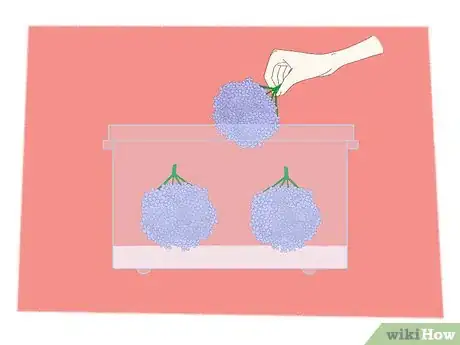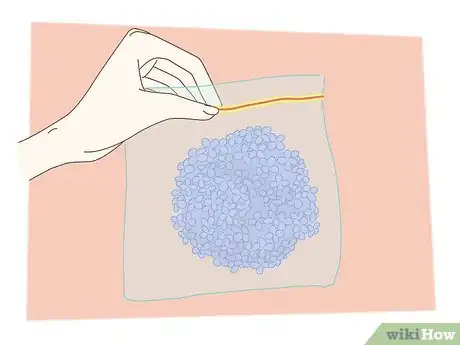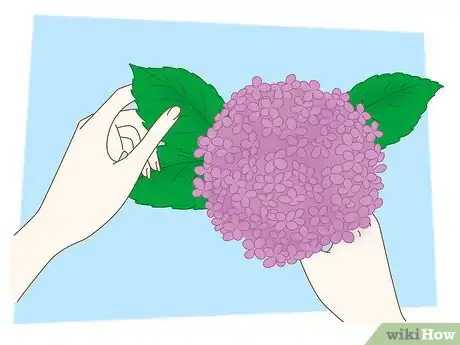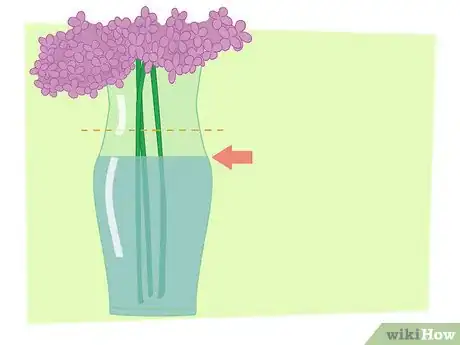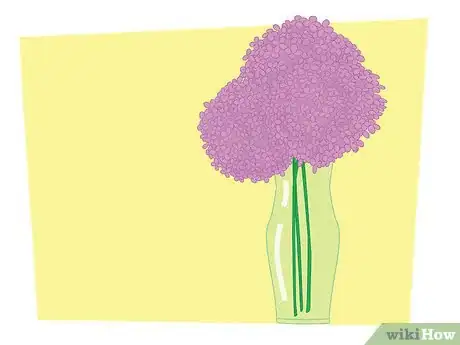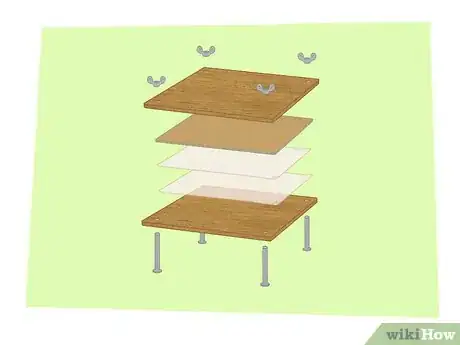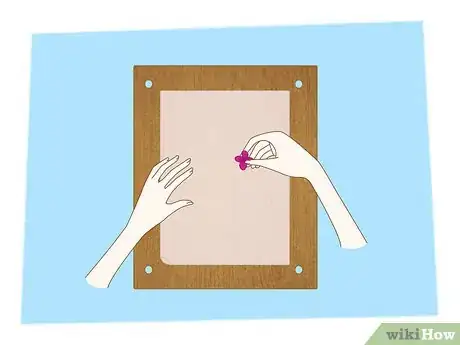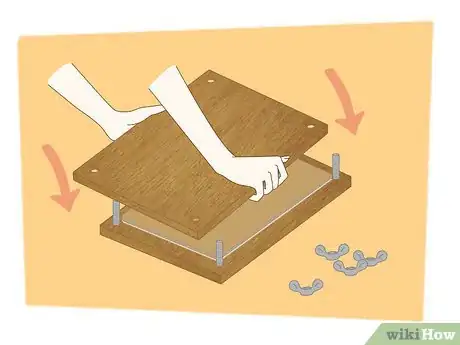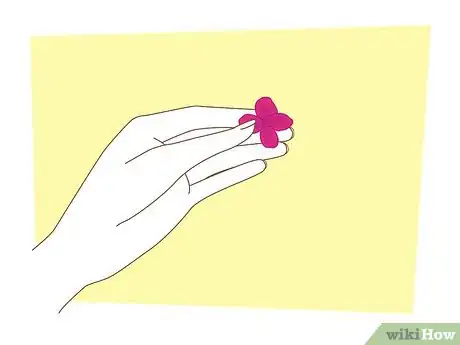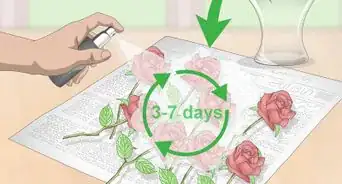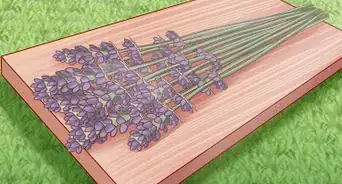wikiHow is a “wiki,” similar to Wikipedia, which means that many of our articles are co-written by multiple authors. To create this article, 14 people, some anonymous, worked to edit and improve it over time.
This article has been viewed 92,939 times.
Learn more...
There are approximately 23 varieties of hydrangeas, which yield a diverse range of colors in shades of white, pink, blue, and lilac. Whether your flowers come from a florist or are grown in your garden, you can extend the beauty of your hydrangeas by drying them. This article provides instructions on how to dry hydrangeas using three different methods: silica gel drying, water drying, and pressing.
Silica Gel Drying
-
1Prepare the flowers for drying. Remove discolored parts and extra leaves, so the flowers are in good shape for drying. Cut the stems down to and or inch 2 (2.35 to 4.7 cm) from the base of the flowers.
-
2Prepare the drying container. Choose a plastic container with a tight-fitting lid to use for drying your flowers. Deeper containers work better than shallow ones, since the flowers will need to be completely submerged in silica gel.
- Pour a thin layer of silica gel in the plastic container. The gel should completely cover the bottom of the container.
- Err on the side of pouring in too much gel to keep the flowers from being crushed against the bottom of the container.
-
3Place the blooms in the container. Take each bloom by the stem and carefully place it bloom-side down into the container. Add as many blooms as will comfortably fit in the container without touching each other or the container's sides.
-
4Add more silica gel. Place enough silica gel in the container to completely surround and support the hydrangeas.
- Hold each flower steady with one hand and sprinkle the gel with the other until the flowers can stand up on their own and are covering the petals and stems. Fill the container with gel until it rises 1/2 inch (1.3 cm) above the blooms in addition to covering the stem.
- If the container is narrow and very deep, you can suspend a flower at the bottom, cover it with silica gel, and add another bloom above it. Just make sure the container is deep enough that the flowers don't touch each other.
-
5Start the drying process. Put a lid on the container. Place it in a corner or a closet to allow the drying process to commence.
- Write the date you submerged the flowers on the container, so you know when it's time to take them out.
- Leave container undisturbed for 4 days. Drying hydrangeas any longer in silica could result in brittle blooms that could shatter.
-
6Remove the blooms from the container. After 4 days, they should be completely dry.
- Open the container and slowly pour the contents onto newspaper. Remove the dry hydrangea blooms and gently tap them to remove any loose silica.
- Save the silica gel in a plastic container for the next time you want to dry flowers.
-
7Store or display the dried hydrangeas. Carefully store the dried hydrangea blossoms in plastic bags until you're ready to use them or place them in a vase.
Water Drying
-
1Prepare the flowers for drying. Remove all but a few leaves, and discard discolored petals. Cut the flower stems to your desired length.
-
2Fill a vase or container with a couple inches of water. Place the flowers stem-side down into the vase, so the stems are submerged at the end of the stem.
-
3Allow the flowers to dry. Your hydrangea will slowly dry as the water gradually evaporates.
- Place the vase out of direct sunlight, since strong sun can cause the flowers to shrivel or fade.
- Don't top off the water, since this may cause the flowers to mold before drying.
- The drying process should take one to two weeks.
-
4Remove the dried flowers. Trim the stems if they are moist or discolored from being submerged in the water. Store the flowers in a plastic bag or place them in a vase and display.
Pressing
-
1Prepare the flowers for pressing. Pressing flowers preserves the color and shape of the petals, but the shape of the hydrangea blossom itself will be flattened.
- Cut the hydrangea blossoms in half to preserve and flatten their round shape.
- Cut individual flowers and plan to arrange them in the shape of a hydrangea blossom after they're dried.
-
2Prepare the press. A press is made with two pieces of plywood that are tightened with screws and wing nuts. Remove the top piece of plywood and lay a piece of cardboard followed by two sheets of parchment or pressing paper on the bottom piece of plywood.
- The cardboard and parchment paper should be cut a few inches smaller than the bottom of the press.
- The bottom sheet of parchment paper is called the "blotter." It absorbs moisture from the drying flower and is switched out every few days. The top sheet of parchment paper anchors the flowers during the drying process.
-
3Lay the flowers on the top sheet of parchment paper. Arrange them so that no petals or folded or crushed, unless you are trying to create a windblown effect.
- A little layering is fine, but don't build too many layers of petals, or they won't dry out correctly.
- If you wish, add other foliage like leaves, ferns and other flowers.
-
4Finish assembling the flower press. Cover the flowers with a sheet of parchment paper, a second "blotter" sheet, a piece of cardboard, and the top piece of the flower press. Screw the plywood pieces together and tighten them with the wing nuts.
-
5Allow the flowers to dry. Set the press in a dry place in your home and let the drying process begin.
- Open the press and change out the blotter sheets every few days. Discard the old sheets and replace them with fresh ones.
- After a week or two, the flowers should be completely dry. Remove them from the press.
-
6Lift the pressed flowers from the parchment paper. They are now ready to use in craft projects such as cards or jewelry. Pressed flowers also look beautiful mounted on a card and framed.
Community Q&A
-
QuestionI want to have a small posy of sweet peas from my garden for my daughter's small, informal wedding. What should I do?
 Community AnswerYour local weather will affect when you will have flowers as well as the variety you choose, so just be sure they're in season.
Community AnswerYour local weather will affect when you will have flowers as well as the variety you choose, so just be sure they're in season. -
QuestionMy two hydranangeas were planted 8 years ago and have never bloomed since. They are located in partial shade near my house.
 LunaCommunity AnswerYou could try to add different natural fertilizers, because it might be the soil that is depleted of essential nutrients. Hydrangeas usually don't need full sunlight and thrive in partial shade. Try clearing out rocks from their bed, and watering them more often. But props to you for keeping them alive for eight years.
LunaCommunity AnswerYou could try to add different natural fertilizers, because it might be the soil that is depleted of essential nutrients. Hydrangeas usually don't need full sunlight and thrive in partial shade. Try clearing out rocks from their bed, and watering them more often. But props to you for keeping them alive for eight years.
Warnings
- AnnaBelle Hydrangea will not dry well with any method other than pressing.⧼thumbs_response⧽
Things You'll Need
Method One: Silica Gel Drying
- Plastic containers
- Cup
- Silica gel (enough to cover the blooms in the plastic containers)
- Newspaper
Method Two: Water Drying
- A vase filled with water
Method Three: Pressing
- A flower press with accompanying pressing papers and cardboard pieces
About This Article
To dry hydrangeas, start by removing any discolored parts and cut the stems down to about an inch from the base of each bloom. Next, pour a thin layer of silica gel into the bottom of a plastic container with a tight-fitting lid. Make sure the bottom of the container is fully covered before carefully placing each bloom into the gel with the bloom-side face down. Then, add more silica gel on top so the flowers are completely surrounded and supported. Finally, put the lid on the container and leave the blooms undisturbed for 4 days. For tips on displaying and storing dried hydrangeas, read on!

